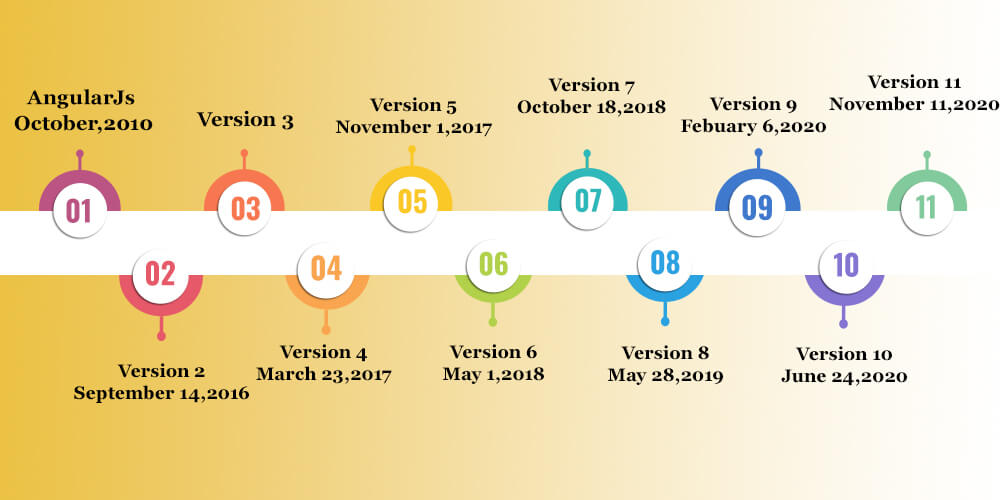Angular and AngularJS are two popular open-source web development frameworks. Developed by Google, Angular is the newer version and has gained widespread popularity due to its advanced features and improved performance. On the other hand, AngularJS is an older version that was introduced in 2010 and has been widely used in web development for several years.
While both frameworks share some similarities, there are significant differences between them. One of the most notable differences is their architecture. AngularJS uses a Model-View-Controller (MVC) architecture, while Angular uses a Component-Based Architecture. Additionally, Angular is written in TypeScript, a superset of JavaScript, while AngularJS is written in JavaScript.
In this article, we will explore the difference between Angular and AngularJS, their key features, advantages, and disadvantages, to help you choose the right framework for your web development project.
What is Angular?
Angular is a popular open-source web development framework developed and maintained by Google. It was first introduced in 2016 as a completely rewritten version of AngularJS. Angular is built using TypeScript, a superset of JavaScript, and offers a range of advanced features and tools for building complex web applications.
Features of Angular:
- Component-Based Architecture: Angular uses a component-based architecture that makes it easy to reuse components across multiple web applications.
- Reactive Programming: Angular uses reactive programming, which allows developers to build highly responsive and scalable applications that can handle large amounts of data.
- Cross-Platform Development: Angular offers cross-platform development capabilities, allowing developers to build web applications that can run on multiple platforms and devices.
- Dependency Injection: Angular uses dependency injection to manage dependencies between components, making it easy to build modular and scalable applications.
- CLI tool: Angular comes with a CLI tool that provides developers, including those at an angular development company, with a set of commands for creating, testing, and deploying Angular applications. This can help speed up development, improve code quality, and streamline the deployment process.
- TypeScript: Angular is built using TypeScript, which provides better type checking, error handling, and code completion compared to JavaScript.
Pros of Angular:
- Improved Performance: Angular is faster and more efficient than AngularJS, thanks to its use of the latest web technologies and advanced features.
- Scalability: Angular offers better scalability than AngularJS, making it suitable for building large and complex web applications.
- Robustness: Angular has a robust and stable codebase, with a large community of developers and a range of tools and resources available for building high-quality web applications.
Cons of Angular:
- Steep Learning Curve: Angular has a steep learning curve, especially for developers who are new to TypeScript and reactive programming.
- Complexity: Angular can be complex, especially for small and simple web applications, which may not require all of its advanced features.
- Compatibility Issues: Angular may have compatibility issues with some older browsers, which may require additional development and testing efforts.
What is AngularJS?
AngularJS is an open-source web development framework developed and maintained by Google. It was first introduced in 2010 and quickly gained popularity among web developers due to its ability to simplify the development process and improve the performance of web applications. AngularJS is built using JavaScript and offers a range of features and tools for building dynamic and interactive web applications.
Features of AngularJS:
- Model-View-Controller (MVC) Architecture: AngularJS uses a Model-View-Controller (MVC) architecture, which separates the presentation, logic, and data layers of the application, making it easier to manage and maintain.
- Two-Way Data Binding: AngularJS offers two-way data binding, which allows changes in the model to be automatically reflected in the view, and vice versa.
- Directives: AngularJS uses directives, which are HTML attributes or elements, to provide additional functionality and make the development process more efficient.
- Dependency Injection: AngularJS uses dependency injection to manage dependencies between components, making it easier to build modular and scalable applications.
- Testing Framework: AngularJS has a built-in testing framework, which makes it easier to test and debug web applications.
Pros of AngularJS:
- Easy to Learn: AngularJS has a relatively low learning curve, making it easy for developers to get started with web development.
- Rapid Development: AngularJS simplifies the development process and provides a range of tools and resources, making it easier to build web applications quickly.
- Compatibility: AngularJS is compatible with most modern web browsers, making it easy to build cross-browser compatible web applications.
Cons of AngularJS:
- Performance: AngularJS can be slower and less efficient than newer web development frameworks, especially for large and complex web applications.
- Scalability: AngularJS can be less scalable than newer web development frameworks, making it less suitable for building large and complex web applications.
- Limited Support: AngularJS is an older technology, and support for it is gradually decreasing, making it less suitable for long-term projects.
Types of Angular and AngularJS Versions

Types of Angular:
- AngularJS (version 1.x): This is the original version of Angular, also known as AngularJS, released in 2010. It uses the Model-View-Controller (MVC) architecture and is written in JavaScript. AngularJS is no longer being actively developed, but it is still used in many web applications today.
- Angular (version 2+): This is the newer version of Angular, which was introduced in 2016. It uses a component-based architecture and is written in TypeScript, a superset of JavaScript. Angular 2+ is backward-incompatible with AngularJS, and it offers a range of advanced features and tools for building complex web applications.
- Angular Elements: Angular Elements is a package that allows developers to use Angular components in non-Angular applications. This allows for easier integration of Angular components into existing web applications.
Types of AngularJS:
- AngularJS (version 1.x): This is the original version of Angular, released in 2010. It uses the Model-View-Controller (MVC) architecture and is written in JavaScript. AngularJS has several sub-versions, including 1.0, 1.2, 1.3, 1.4, 1.5, and 1.6.
- AngularJS 2.0: This version of AngularJS was never released, as the development team decided to completely rewrite the framework, resulting in the creation of Angular (version 2+).
There are two main types of Angular: AngularJS (version 1.x) and Angular (version 2+), and there are several sub-versions of AngularJS (1.0-1.6). While AngularJS is no longer being actively developed, it is still widely used in many web applications today. On the other hand, Angular (version 2+) is the newer and more advanced version of the framework, offering a range of advanced features and tools for building complex web applications.
Major Difference Between Angular and AngularJS?
- Architecture: AngularJS uses the Model-View-Controller (MVC) architecture, while Angular uses a component-based architecture.
- Language: AngularJS is written in JavaScript, while Angular is written in TypeScript, a superset of JavaScript.
- Two-Way Data Binding: AngularJS uses two-way data binding, while Angular uses one-way data binding, making it more efficient and easier to debug.
- Directives: AngularJS uses directives, which are HTML attributes or elements, while Angular uses components, which are more powerful and easier to reuse.
- Performance: Angular is faster and more efficient than AngularJS, especially for larger and more complex web applications.
- Mobile Development: Angular has better support for mobile development, making it easier to build cross-platform mobile applications.
- Community Support: Angular has a larger and more active community than AngularJS, with more resources, documentation, and tools available.
- Backward Compatibility: Angular is not backward-compatible with AngularJS, meaning that applications written in AngularJS need to be completely rewritten to work in Angular.
FAQs on AngularJs Vs angular
Q: What is the main difference between Angular and AngularJS?
A: The main difference between Angular and AngularJS is their architecture. AngularJS uses the Model-View-Controller (MVC) architecture, while Angular uses a component-based architecture.
Q: What language is AngularJS written in?
A: AngularJS is written in JavaScript.
Q: What language is Angular written in?
A: Angular is written in TypeScript, a superset of JavaScript.
Q: What is two-way data binding and which framework uses it?
A: Two-way data binding is a feature that allows changes to the model to be automatically reflected in the view, and vice versa. AngularJS uses two-way data binding, while Angular uses one-way data binding.
Q: What are directives and components?
A: Directives are HTML attributes or elements used in AngularJS to attach behaviors to the DOM. Components are more powerful and easier to reuse than directives and are used in Angular.
Q: Which framework is faster, AngularJS or Angular?
A: Angular is faster and more efficient than AngularJS, especially for larger and more complex web applications.
Q: Is AngularJS still being actively developed?
A: No, AngularJS is no longer being actively developed, but it is still used in many web applications today.
Q: Are Angular and AngularJS backward-compatible?
A: No, Angular is not backward-compatible with AngularJS, meaning that applications written in AngularJS need to be completely rewritten to work in Angular.
Q: Which framework has better community support?
A: Angular has a larger and more active community than AngularJS, with more resources, documentation, and tools available.
























